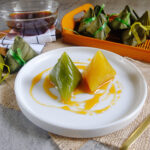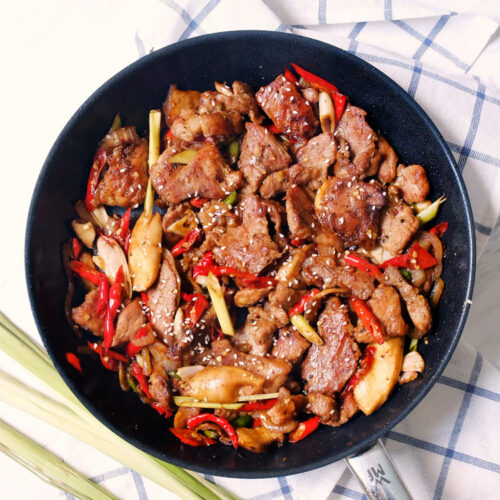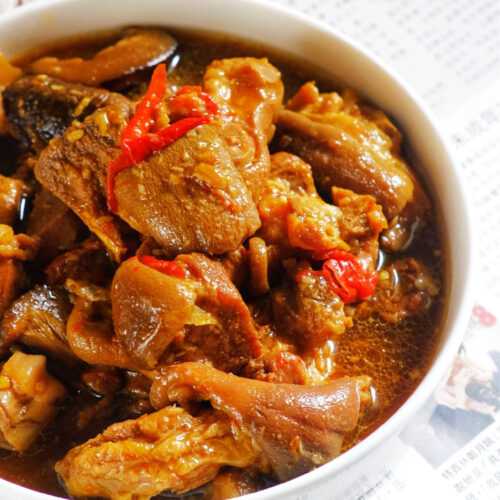
Back on 25th June, which was the Dragon Boat Festival. I posted this photo on my Instagram account. This is Pandan Kee Chang and Original Kee Chang also known as Alkaline Dumplings.
Jump to RecipeWhat is Dragon Boat Festival?
The Dragon Boat Festival is a traditional holiday that occurs on the 5th day of the 5th month of the traditional Chinese calendar. Which usually falls in May or June (depending on the Chinese Lunar Calendar). The Chinese calendar is lunisolar, so the date of the festival varies from year to year on the Gregorian calendar.
Dragon Boat Festival for us means we will get to eat a lot of sticky rice dumplings! There are two types of sticky rice dumplings; one is sweet (Kee Chang) and one is savoury (Bak Chang). Both are Hokkien/Hokkian meal that is very famous in South East Asia.
What is Alkaline Dumplings?
As its name suggested, it’s glutinous rice or sticky rice is mixed with alkaline water that makes the dumplings chewy and bouncy. The original alkaline is yellow colour but in this recipe, I was making two batches, Pandan and Original. The glutinous rice is then wrapped in a cone-shaped using bamboo leaves and then boiled to cook.
A notable part of celebrating Dragon Boat Festival is making and eating glutinous rice dumplings with family members and friends. People traditionally wrap glutinous rice dumplings in leaves of bamboo, forming a pyramid shape. The leaves also give a special aroma and flavor to the sticky rice and fillings.
Choices of fillings vary depending on regions. Northern regions in China prefer sweet or dessert-style glutinous rice dumplings, with bean paste, jujube, and nuts as fillings. As for South East Asia, we use mostly palm sugar and but Medanese people like to add Kaya jam on their alkaline dumplings.
Pandan Kee Chang & Original Kee Chang (Alkaline Dumplings)
Equipment
- Saucepan
- Large Pot
Ingredients
Pandan Alkaline Dumpling
- 500 grams Glutinous Rice
- 2 tbsp Alkaline Water a.k.a Air Abu in Indonesia
- 1 tbsp Cooking Oil Vegetable oil is recommended
- 10 stems Pandan Leaves use Pandan extract if there is no fresh Pandan
- 300 ml Water
Dumplings Wrapper
- 20 pcs Bamboo Leaves
- 1 roll Kitchen Twine to tie the dumplings
- 1 m Colourful Raffia Twine – if you make different flavours
Palm sugar coconut milk syrup
- 250 grams Palm Sugar
- 50 ml Water
- 100 ml Coconut Milk
Instructions
Prepare The Wrapper
- Clean and then soak all the bamboo leaves in the water a day before you plan to boil the dumplings.
- Drain off the water. Then, wipe them dry.
Prepare The Syrup
- Place the palm sugar and the water in a saucepan. Cook until the palm sugar has melted.
- Add in the coconut milk and stir well until the mixture is slightly thickened.
- Store in a glass bowl or jar in the refrigerator. It will last up to 10 days.
Prepare The Rice
- Prepare saucepan, boil pandan leaves to get the pandan water.
- Soak the rice overnight with pandan water for a minimum of 8 hours.
- Drain off the water. The rice should be green by now.
- Add alkaline water and cooking oil. For better strong flavour, feel free to add 2 drops of Pandan extract (but not necessary).
Wrapping The Dumplings
- Lay two bamboo leaves horizontally.
- Fold in the middle to make a cone shape.
- Fill with about 2 tbsp of glutinous rice. Press it gently to fill the cone shape like triangle filling.
- Don't fill all the way up or the dumpling will burst open when cooked because the rice will expand.
- Fold both sides down then fold the other side diagonally to create a triangle shape.
- Secure it with kitchen twine. Don't tie it too tight otherwise, the dumpling will have a pear shape.
Boiling The Dumplings
- Prepare the large pot.
- Place the dumplings inside and fill it up with water, make sure to cover the surface of the dumplings.
- Boil for 2 hours
To make the original alkaline dumplings, simply get rid of the pandan water ingredients. Soak the rice with water instead. Typically, if I only make one flavour (original) I would always use kitchen twine. But because these are two different flavours, it’s good to use raffia twine after boiling it with kitchen twine to differentiate the flavours.
How to know when the Kee Chang is done? Test it by getting one out from the pot and when it’s cool enough to handle, gently open up the leaves. If the glutinous rice doesn’t fall apart and hold up together nicely, then it’s done cooking. If the glutinous rice falls apart easily, we need to boil longer.
I grew up with original Kee Chang without any filling like red bean, etc. It’s usually served with palm sugar syrup. I just simply dip the Kee Chang in a bowl of palm sugar syrup. I can eat 20 pcs in one sitting! How many can you eat?



